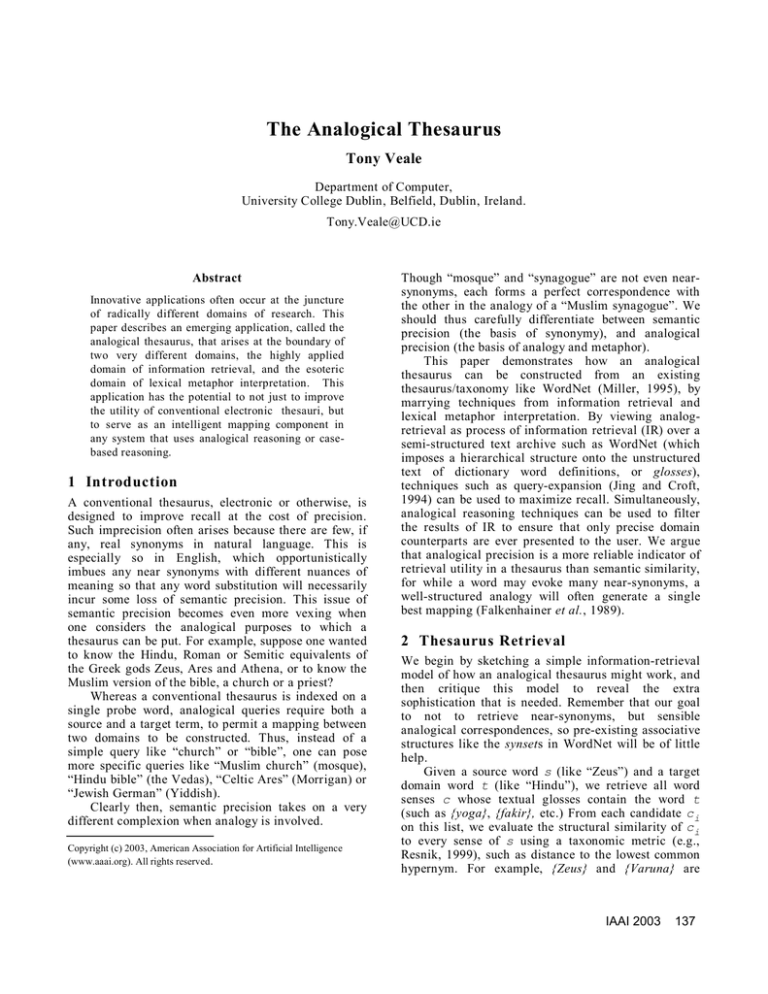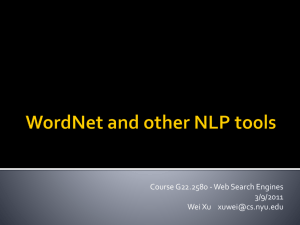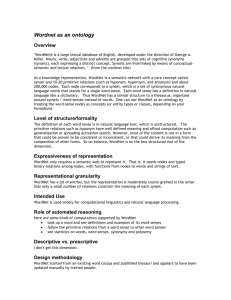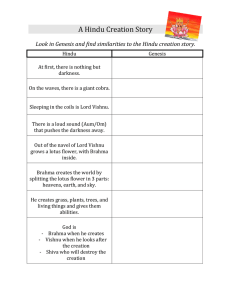Abstract Though “mosque” and “synagogue” are not even near-
advertisement

The Analogical Thesaurus
Tony Veale
Department of Computer,
University College Dublin, Belfield, Dublin, Ireland.
Tony.Veale@UCD.ie
Abstract
Innovative applications often occur at the juncture
of radically different domains of research. This
paper describes an emerging application, called the
analogical thesaurus, that arises at the boundary of
two very different domains, the highly applied
domain of information retrieval, and the esoteric
domain of lexical metaphor interpretation. This
application has the potential to not just to improve
the utility of conventional electronic thesauri, but
to serve as an intelligent mapping component in
any system that uses analogical reasoning or casebased reasoning.
1 Introduction
A conventional thesaurus, electronic or otherwise, is
designed to improve recall at the cost of precision.
Such imprecision often arises because there are few, if
any, real synonyms in natural language. This is
especially so in English, which opportunistically
imbues any near synonyms with different nuances of
meaning so that any word substitution will necessarily
incur some loss of semantic precision. This issue of
semantic precision becomes even more vexing when
one considers the analogical purposes to which a
thesaurus can be put. For example, suppose one wanted
to know the Hindu, Roman or Semitic equivalents of
the Greek gods Zeus, Ares and Athena, or to know the
Muslim version of the bible, a church or a priest?
Whereas a conventional thesaurus is indexed on a
single probe word, analogical queries require both a
source and a target term, to permit a mapping between
two domains to be constructed. Thus, instead of a
simple query like “church” or “bible”, one can pose
more specific queries like “Muslim church” (mosque),
“Hindu bible” (the Vedas), “Celtic Ares” (Morrigan) or
“Jewish German” (Yiddish).
Clearly then, semantic precision takes on a very
different complexion when analogy is involved.
Copyright (c) 2003, American Association for Artificial Intelligence
(www.aaai.org). All rights reserved.
Though “mosque” and “synagogue” are not even nearsynonyms, each forms a perfect correspondence with
the other in the analogy of a “Muslim synagogue”. We
should thus carefully differentiate between semantic
precision (the basis of synonymy), and analogical
precision (the basis of analogy and metaphor).
This paper demonstrates how an analogical
thesaurus can be constructed from an existing
thesaurus/taxonomy like WordNet (Miller, 1995), by
marrying techniques from information retrieval and
lexical metaphor interpretation. By viewing analogretrieval as process of information retrieval (IR) over a
semi-structured text archive such as WordNet (which
imposes a hierarchical structure onto the unstructured
text of dictionary word definitions, or glosses),
techniques such as query-expansion (Jing and Croft,
1994) can be used to maximize recall. Simultaneously,
analogical reasoning techniques can be used to filter
the results of IR to ensure that only precise domain
counterparts are ever presented to the user. We argue
that analogical precision is a more reliable indicator of
retrieval utility in a thesaurus than semantic similarity,
for while a word may evoke many near-synonyms, a
well-structured analogy will often generate a single
best mapping (Falkenhainer et al., 1989).
2 Thesaurus Retrieval
We begin by sketching a simple information-retrieval
model of how an analogical thesaurus might work, and
then critique this model to reveal the extra
sophistication that is needed. Remember that our goal
to not to retrieve near-synonyms, but sensible
analogical correspondences, so pre-existing associative
structures like the synsets in WordNet will be of little
help.
Given a source word s (like “Zeus”) and a target
domain word t (like “Hindu”), we retrieve all word
senses c whose textual glosses contain the word t
(such as {yoga}, {fakir}, etc.) From each candidate ci
on this list, we evaluate the structural similarity of ci
to every sense of s using a taxonomic metric (e.g.,
Resnik, 1999), such as distance to the lowest common
hypernym. For example, {Zeus} and {Varuna} are
IAAI 2003
137
structurally similar to the extent that they share the
grandparent {deity, god}. Those candidate senses ci
whose similarity to s fall below a certain threshold are
rejected, while those that remain are ranked in
descending order of similarity and displayed to the
user. This straw-man approach works well in many
cases, and can answer such queries as “Who is the
French Beckett?” (Victor Hugo) and “What is Hebrew
German?” (Yiddish). However, there are significant
problems that make it largely unusable.
First, the most desirable candidate words may not
contain the target word t in their glosses, but may only
implicitly relate to t via a hypernym. For instance,
while {Varuna} is a hyponym of {Hindu_deity} in
WordNet 1.6, it has a meager gloss, “supreme cosmic
deity”, in which no explicit reference to any aspect of
Hindu culture is made. Secondly, taxonomic
discrimination of good candidates from bad is only
effective on a coarse-grained basis. For instance, we
can rely on the structure of WordNet to recognize that
hyponyms of {deity, god} (such as {Aditi} and
{Avatar}) make better candidates than hyponyms of
{person} (like {fakir} or {Gurkha}). But we cannot
depend on WordNet to discriminate between {Varuna}
and {Aditi} on a taxonomic basis, since the relevant
criterion (supremacy within one’s pantheon) is not
coded taxonomically in WordNet 1.6, but simply stated
in the glosses.
The first problem can be resolved by adapting to
the vagaries of word usage in WordNet sense glosses,
by using query expansion to cast a wider retrieval net.
For example, (Jing and Croft, 1994) use a thesaurus to
perform query expansion. The second problem requires
that we adapt WordNet itself, to make fine-grained
taxonomic discrimination a reality. That is, we need to
unlock the implicit structural information contained in
WordNet’s glosses, and reify this information to the
level of taxonomic structure. Thus, {Zeus} and
{Varuna} would become hyponyms of a new taxonomic
node, {supreme_deity}, such that the presence of this
node will introduce greater discrimination into
structural similarity metrics.
3 Taxonomic Discrimination
Taxonomic systematicity implies that related or
analogous domains should be differentiated in the same
ways, so that similarity judgments in each domain can
be comparable. But in very large taxonomies, this
systematicity is often lacking. For example, in
WordNet 1.6, the concept {alphabet} is differentiated
culturally
into
{Greek_alphabet}
and
{Hebrew_alphabet},
but
the
concept
{letter,
alphabetic_character} is not similarly differentiated
into {Greek_letter} and {Hebrew_letter}. Rather, every
letter of each alphabet, such as {alpha} and {aleph}, is
located under exactly the same hypernym, {letter,
alphabetic_character}. On structural grounds alone
then, each letter is equally similar to every other, no
matter what alphabet they belong to (e.g., alpha is as
similar to aleph as it is to beta).
An analogical thesaurus would thus be unable to
separate good analogues from bad using structural
similarity, and in examples such as “Jewish alpha”,
would return the entire Hebrew alphabet as candidates.
To achieve competent analogical mapping then, it is
vital that these deficiencies are automatically
recognized and repaired. We thus identify an important
class of taxonomic support structure for analogies that
we dub an “analogical pivot”, and show how
taxonomies like WordNet, which contain relatively few
natural pivots, can be automatically enriched with
thousands of new pivots that significantly expand its
potential for analogical reasoning. Though we limit
our current discussion to the WordNet noun taxonomy,
we predict that these techniques are equally applicable
to other ontologies, like that of Cyc (Lenat and Guha,
1991).
3.1
Analogical Composition
Consider again the analogical query “Hindu Zeus” and
how one might resolve it using WordNet. The goal is
to find a counterpart for the source concept Zeus (the
supreme deity of the Greek pantheon) in the target
domain of Hinduism. In WordNet 1.6, {Zeus} is a
daughter of {Greek_deity}, which is turn is a daughter
of {deity, god}. Now, because WordNet also defines an
entry for {Hindu_deity}, it requires just a simple
concatenative composition of ideas to determine that
the “Hindu Zeus” will be daughter of the node
{Hindu_deity}. More generally, one finds the lowest
parent of the head term (“Zeus”) that, when
concatenated with the modifier term (“Hindu”) or some
synonym thereof, yields an existing WordNet concept.
In effect, the mapping process uses the pivot to
construct a target counterpart of the source concept
that significantly narrows the space of possible
correspondences.
So the Hindu counterpart of Zeus is not
{Hindu_deity}, but one of the relatively few daughter
nodes of this target-domain differentiation of the pivot
{deity, god}. Compare this compositional approach
with the conventional one of taxonomic reconciliation,
due to Aristotle (Hutton, 1982), in which two nodes
can be considered analogous if they share a common
superordinate. This approach still finds considerable
Taxonomic Ideal
{LETTER, ALPHABETIC_CHARACTER}
isa
isa
isa
isa
{ALPHA}
isa
isa
isa
isa
{DALETH}
…
{GIMEL}
{BETA}
{GAMMA}
{DELTA}
{ALEPH}
{BETH}
Figure 1: The impoverished sub-taxonomy of {letter, alphabetic_character} as found in WordNet 1.6
differentiated into Greek and Hebrew alphabets, so a
mapping cannot be constructed for “Jewish delta”
{Hebrew_letter}. Figure 1 illustrates the structure (and
lack thereof) of the letter domain in WordNet 1.6.
Secondly, even when pivots do exist to facilitate a
mapping, what is constructed is a broad target
hypernym rather than a specific domain counterpart.
One still needs to go from {Hindu_deity} to {Varuna}
(like Zeus a supreme cosmic deity, but of Hinduism),
or from {Hebrew_letter} to {daleth} (like “delta” the
fourth letter, but of the Hebrew alphabet).
4 Adding Fine-Grained Distinctions
The current approach avoids triviality by seeking not
just any common hypernym, but a hypernym whose
lexical form explicitly encodes a juncture of the source
and target concepts. However, this compositional
approach is still fragile on a number of accounts. First,
we note that natural pivots like {deity, god} are
extremely rare in a taxonomy like WordNet, which has
not been explicitly constructed for analogical purposes.
For instance, as noted earlier, the WordNet concept
{letter, alphabetic_character} is not taxonomically
Taxonomic Ideal
isa
{GREEK_LETTER}
{LETTER, ALPHABETIC_CHARACTER}
isa
isa
isa
ST
{1 _LETTER}
isa
RD
{2ND_LETTER}
{3 _LETTER}
isa
…
isa
isa
isa
{ALPHA}
isa
{BETA}
{HEBREW_LETTER}
isa
…
isa
isa
{GAMMA}
isa
isa
{ALEPH}
isa
{BETH}
isa
{GIMEL}
Figure 2: The taxonomic structure of {letter, alphabetic_character} becomes a richly structured lattice when
enriched with a variety of new types like {Greek_letter} and {1st_letter}
However, both problems can be solved by creating
additional differentiating nodes that will dissect the
taxonomy in new ways. In turn, this will convert the
existing hypernyms of these nodes into analogical
pivots whose hyponyms are explicitly labeled by
domain. For example, the creation of differentiator
nodes like {Greek_letter} and {Hebrew_letter} will
transform {letter, alphabetic_character} into a pivot
that extends into the Greek and Hebrew domains (see
Figure 2 below). Nodes such as these act as
concatenative junctures of different domains, and
serve as signposts from the pivot into more
specialized areas of the taxonomy. In contrast, other
differentiator nodes may be less ambitious: a new
node like {1st_letter} will unite just two hyponyms,
{alpha} and {aleph}. However, these lower-level
differentiators allow for finer-grained mapping
within the established target domain, once the
appropriate area of the taxonomy has been identified
using the pivot.
IAAI 2003
139
and {supreme_being} – for its explicit use as a
differentiator. And of the concepts that “supreme” is
used to gloss, six –
{Zeus}, {Jove}, {Jupiter},
{Cronos}, {Wotan} and {Varuna} – are equidistant
grand-daughters of the concept {deity, god}. The
symmetry one expects in analogy is thus present,
suggesting that “supreme” can be reified to create a
new taxonomic concept {supreme_deity}. This
situation is illustrated in Figure 3.
In general, any interior non-leaf node of the
taxonomy can be a potential pivot node, but from a
practical perspective, it makes sense to only consider
the atomic concepts that have not already been
differentiated. Thus, {deity, god} is a potential pivot
but {Greek_deity} is not, since the latter is already
specific to the {Greek} domain. For efficiency reasons,
we use the following identification rule:
Enhancing the differentiating power of WordNet in
this way is essentially a task of feature reification.
WordNet, like other taxonomies, such as Cyc (Lenat
et al. 1990), expresses some of its structure
explicitly, via isa-links, and some of it implicitly, in
textual glosses intended for human rather than
machine consumption. Fortunately, these glosses are
consistent enough to permit automatic extraction of
structural features. What is needed then is a means
to recognize the word features in these glosses with
the most analogical potential, so that they may be
‘lifted’ to create new taxonomic nodes. We employ
two broad criteria to identify the word forms worth
reifying in this way:
Defn:
A
lemmatized
word-form
has
differentiation potential if it occurs in more than
one gloss, but not in too many (e.g., more than
1000). Additionally, there must be a precedent for
using the word as an explicit differentiator in at
least one existing taxonomic entry.
Defn: A hypernym X is a potential pivot relative
to a hyponym Y if X is the lowest, undifferentiated
(atomic) hypernym of Y.
Defn: A lemmatized word-form has alignment
potential if it can be found in multiple locations of
the taxonomy at the same relative depth from a
potential pivot.
Thus, when we consider the word forms in the gloss of
{Zeus}, alignability is determined relative to the
concept {deity, god} rather than {Greek_deity}, so that
any reification that is performed will create a new
differentiation of the former. The analogical thesaurus
can exploit a reverse-index of gloss words to the
concepts defined using them, to make this
identification of alignable features very efficient.
Consider the word “supreme”, which occurs in 42
different WordNet 1.6 glosses, enough to demonstrate
cross-domain potential but not too many to suggest
vagueness. Additionally, there are three WordNet
precedents – {supreme_court}, {supreme_authority}
{ deity, god}
{Greek_deity}
greek
hindu
supreme
…
{Hindu_deity}
…
{Supreme_deity}
{Skanda}
{Ares}
{Athena}
{Varuna}
{Zeus}
Defn: the supreme god of …
{Ganesh}
Defn: supreme cosmic deity
alignable
Figure 3: The word-form “supreme” has analogical potential in the gloss of {Zeus}, since it is alignable with
another use in {Varuna} at the same relative depth from {deity, god}
5
Experimental Evaluation
To evaluate the effectiveness of an analogical thesaurus
based on an automatically enriched version of
WordNet, 69,780 unique noun senses in WordNet 1.6
were analyzed, to find those senses which would
benefit structurally from the reification of one or more
140
IAAI 2003
textual features. The glosses of these unique senses
collectively contain 35,397 unique (unlemmatized)
content words, but because of the strict reification
criteria for feature-lifting from glosses, only 2806 of
these content words demonstrate both alignability and
differentiability. These 2806 words are reified in the
context of specific pivot concepts to add 9822 new
differentiator nodes, like {supreme_deity} and
{cheese_dish}, to WordNet. In turn, these nodes serve
to differentiate 2737 existing nodes in WordNet, like
{deity} and {dish}, transforming these nodes into
analogically-useful pivots.
In total, 18922 noun concepts (27% of the sample)
are connected to the new differentiator nodes, via the
addition of 28,998 new isa-links to WordNet. Each
differentiator thus serves to unite an average of 3
daughters apiece. A review of the other 87.2% of
differentiators reveals that WordNet is being dissected
in new and useful ways, both from the perspective of
simple similarity judgments (e.g., the new types
achieve a fine-grained clustering of similar ideas) and
from the perspective of analogical potential. Overall,
the most differentiating feature is “Mexico”, which
serves to differentiate 34 different pivots (such as
{dish}, to group together {taco}, {burrito} and
{refried_beans}), while the most differentiated pivot is
{herb, herbaceous_plant}, which is differentiated into
134 sub-categories (like {prickly_herb}). To consider
just a few other domains: sports are differentiated into
team sports, ball sports, court sports, racket sports and
net sports; constellations are divided according to
northern and southern hemispheric locales; food dishes
are differentiated according to their ingredients, into
cheese dishes, meat dishes, chicken dishes, rice dishes,
etc.; letters are differentiated both by culture, giving
Greek letters and Hebrew letters, and by relative
position, so that “alpha” is both a {1st_letter} and a
{Greek_letter}, while “Aleph” becomes both a
{1st_letter} and a {Hebrew_letter}; and deities are
further
differentiated
to
yield
{war_deity},
Common Basis
supreme
wisdom
beauty, love
sea
fertility
queen
war
hearth
moon
sun
Greek
Zeus
Athena
Aphrodite
Poseidon
Dionysus
Hera
Ares
Hestia
Artemis
Apollo
Roman
Jove
Minerva
Venus
Neptune
Ops
Juno
Mars
Vesta
Diana
Apollo *
{love_deity}, {wine_deity}, {sea_deity}, {sky_deity},
{thunder_deity}, {fertility_deity}, and so on.
These new additions, what we might call dynamic
types since they are created as needed, are primarily
intended to increase the precision, rather than the
recall rate, of analogical mapping. Consider, for
example, the alphabet mapping task, in which the 24
letters of the Greek alphabet are mapped onto the 23
letters of the Hebrew alphabet (as represented in
WordNet), and vice versa. The recall rate for the
Hebrew to Greek letter task, for both dynamic and
static WordNet hierarchies, is 100%, while for the
reverse task, Greek to Hebrew, it is 96% (since Greek
contains an extra letter). However, the precision of the
static hierarchy is only 4%, since every letter of the
target alphabet appears equally similar as a candidate
mapping (Fig. 2). In contrast, the dynamic hierarchy
achieves 96% precision (for Greek to Hebrew
alphabets) and 100% (for Hebrew to Greek alphabets).
Table 1 presents a cross-section of the various subdomains of {deity, god} in WordNet as they are
organized by new dynamic types such as
{supreme_deity}. Where a mapping is unavailable for
cultural reasons, N/A is used to fill the corresponding
cell. In two cases, marked by (*), an adequate mapping
could not be generated when one was culturally
available. In the case of {Odin}, this is due to the
brevity of the gloss provided by WordNet 1.6, which
defines Odin as a “ruler of the Aesir” rather than the
supreme deity of his pantheon. In the case of {Apollo},
a Greco-Roman deity, the failure is due to this entity
being defined as a Greek deity only in WordNet 1.6.
Hindu
Varuna
Ganesh
Kama
N/A
N/A
Aditi
Skanda
Agni
Aditi
Rahu
Norse
Odin *
N/A
Freyja
N/A
Freyr
Hela
Tyr
N/A
N/A
N/A
Celtic
N/A
Brigit
Arianrhod
Ler
Brigit
Ana
Morrigan
Brigit
N/A
Lug
Table 1: Mappings between sub-domains of the type {deity, god} in WordNet 1.6
The data of Table 1 allows for 20 different mapping
tasks in the deities domain (Greek to Roman, Roman to
Hindu, etc.). Averaging over the precision and recall
achieved on these mapping tasks, we notice a distinct
increase in competence when analogical pivots are
used to dynamically augment the WordNet hierarchy.
Thus, when a dynamic hierarchy is used (i.e., WordNet
1.6 augmented with the pivot identification and
creation techniques of section 3), the average recall
rate over these 20 mapping tasks is 61%. This
moderate performance is as good as one can expect
given the nature of the deity systems in these different
cultures, since some pantheons are less fleshed out
than others. For example, the best precision that a
IAAI 2003
141
human can achieve on the Norse to Hindu mapping is
just 40%, because of the inherent differences of
emphasis in each of these mythological systems. The
current system achieves 30% because misses one of the
four sensible correspondences, between Odin and
Varuna, because of the unhelpful gloss associated with
{Odin} in WordNet 1.6.
In contrast for the static hierarchy approach
(WordNet 1.6 without additional pivot creation
techniques), average recall is significantly lower at
34%, since many concepts are not indexed on the
appropriate reference terms due to poorly defined
glosses (e.g., Varuna is defined simply as “supreme
cosmic deity” in WordNet 1.6, with no explicit
reference to Hinduism).
Average precision for the dynamic hierarchy
approach is 93.5%, with the loss of 6.5% precision due
to the items marked (*) in Table 1. In contrast, average
precision for the static hierarchy approach is just
11.5%, and would be lower still if not for the indexing
issues arising out of incomplete glosses, which help to
reduce the number of incorrect answers that the static
hierarchy can actually retrieve.
6
Conclusions
Manually constructed representations on the ambitious
scale of WordNet and Cyc are naturally prone to
problems of incompleteness and imbalance. The ‘onesize-fits-all’ nature of the task results in a taxonomy
that is often too undifferentiated for precise similarity
judgments and too lopsided to support metaphor and
analogical mapping. A symptom of this incompleteness
is the fact that English glosses or commentaries
provide the ultimate level of differentiation, so that one
cannot truly differentiate two concepts without first
understanding what the glosses mean. This
understanding is vital to operation of an analogical
thesaurus, so our goal has been to lift implicit
discriminators out of the flat text of the glosses and
insert them into the taxonomy proper, to facilitate finer
similarity judgments and richer analogical mappings.
We view the analogical thesaurus as both a useful
component of larger systems (such as those that use
analogy for case retrieval) and as a useful endapplication in its own right, serving to enhance the
creative reach of existing thesauri and writer’s tools,
while simultaneously increasing the precision of these
tools. This is perhaps the most counter-intuitive aspect
of the analogical thesaurus, as it allows a user to
retrieve semantically distant word senses with greater
precision than conventional thesauri allow the retrieval
of near-synonyms. This paradox of sorts arises out of
the distinction between semantic precision and
analogical precision: though a more ambitious form of
retrieval, analogical retrieval is guided by both a
source and target marker to guide its deliberation,
allowing one can to meaningfully talk of a perfect
correspondence between highly dissimilar words.
References
Fass, D. 1988. An Account of Coherence, Semantic
Relations, Metonymy, and Lexical Ambiguity
Resolution. In: S. Small, G. W. Cottrell and M. K.
Tanenhaus (eds.): Lexical Ambiguity Resolution:
Perspectives from Psycholinguistics, Neuropsychology
and Artificial Intelligence. Morgan Kauffman: San
Mateo, CA.
Falkenhainer, B., Forbus, K., Gentner, D. 1989.
Structure-Mapping Engine: Algorithm and Examples.
Artificial Intelligence, 41, pages 1-63.
Hutton, J. 1982. Aristotle's Poetics. Norton: NY.
Jing, Y and Croft, W. B. 1994. An association
thesaurus for information retrieval.




